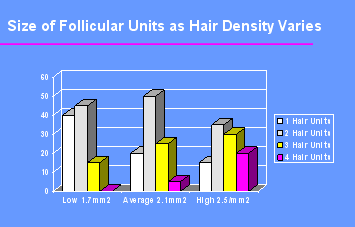Robert M. Bernstein, MD, New York, NY
Hair Transplant Forum International 1998; 8(1): 27.
Dr. Jim Arnold should be congratulated on another excellent and detailed reporting of the ISHRS meeting. We appreciate the inordinate amount of time and effort that he has spent in recording the vast amounts of information that speed by us so quickly. It is amazing how he does it! In reading the article in the Nov.-Dec. 1997 Forum, Vol. 7, No. 6, p. 5, I noticed three small errors in the text that should be corrected. I thought that I might also take the opportunity to briefly discuss them.
The text reads “Some patients may average 1or 2 hairs per unit, while others 4 to 5.” While we do see patients with very low density, or Asians, who average 1 or 2 hairs per unit, I have not seen patients who average 4-5 hairs per unit. Patients with high density, can have a significant number of 4, or rarely 5 hair follicular units, but this is not their average. The graph that I presented in Barcelona, illustrating this point is shown here. Another important point is that the density (spacing) of naturally occurring follicular units is relatively constant at about 1 group/mm2 in the posterior scalp of most Caucasians, but is less in the Black races (where it averages approximately 0.6/mm2).
The text also reads “Dr. Limmer finds the average number 2.3 hairs per unit, while Dr. Bernstein feels the number is closer to 3.” This is also incorrect. As I stated in my presentation, the majority of patients that we see in consultation that are surgical candidates range from 1.5 hairs/unit to 3.0 hairs/unit with an average of 2.0 hairs /unit (rather than 3). The population that actually go on to have surgery have slightly higher groupings at approximately 2.1/hairs per follicular unit. (The graph also illustrates this point).
The numbers that I presented were based upon densitometry readings at the time of the consultation, taken approximately 5 cm to the left or right of the occipital protuberance. Only full-thickness terminal hairs were counted. Dr. Limmer and I spoke regarding the slight differences that we each observed and we felt that different patient populations might be a factor contributing to this small difference. The location on the scalp where the measurements were taken will also influence the results, as the follicular unit density is generally highest in the midline of the donor area and decreases laterally.
Having prior knowledge of the approximate proportion of each of the different size follicular units that will be obtained in the dissection is extremely important in planning the transplant, since the larger units can be concentrated in select areas to create the appearance of greater central density without having to increase the “closeness” of the sites. These numbers are also important because the pre-operative measurement of density and the estimation of follicular unit size are two means of assessing the accuracy of the follicular unit dissection.
The other statement “Hair diameter plays a significant role, as diameter may range by a factor of 5X among patients.” is also incorrect. The word “diameter” should be replaced with the words “Cross Sectional Area.” The range in terminal hair shaft diameter is approximately 2.3 fold (0.06 mm for very fine hair and 0.14 mm for the coarse hair that we often see in Asians). This represents a variation in x-sectional area of approximately 5.4 fold, since area = ~r2 or ~(1/2d)2.
It is interesting to note that compared to hair density, hair shaft diameter plays a much more significant role in the volume or “bulk” of the transplant. The range in hair density in patients that we generally transplant is from 150 hairs/cm2 in those of low density, to around 300 hairs/cm2 for those with the highest. In our practice, we rarely transplant patients who present with a density of less that 150/hairs cm2 (except for Blacks and Asians) and uncommonly see patients with a density greater than 300 hairs/cm2. The range is thus a 2-fold difference. If we compare this to the 5.4 fold range in hair cross-sectional area, we see that, in theory, variations in hair diameter should have 2.7 times the cosmetic impact of variations in hair density.
In reality, these variables are not totally independent. For example, the widest hair shaft diameters are not generally seen in the same patients who have the highest hair densities. Nevertheless, one can make a strong argument for the quantitative assessment of hair shaft diameter, as well as density, in the pre-operative evaluation of patients considering hair transplantation.





